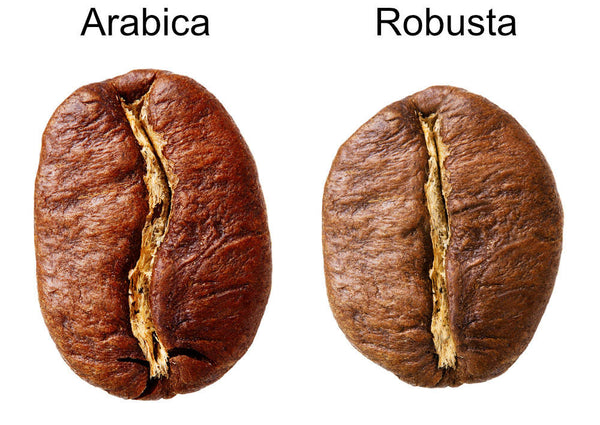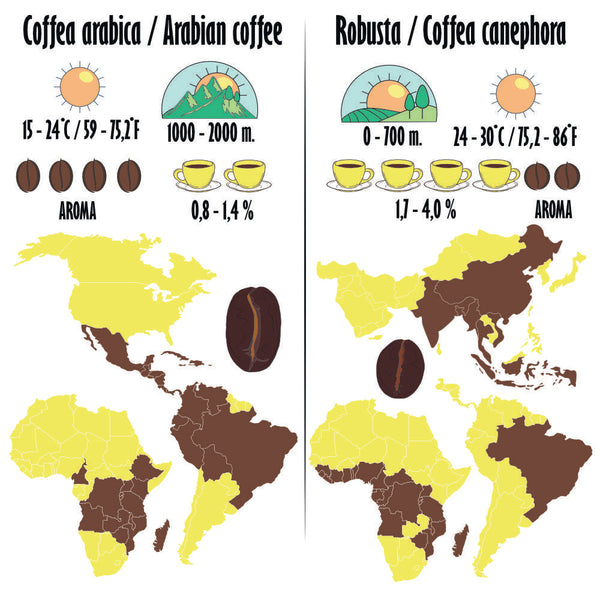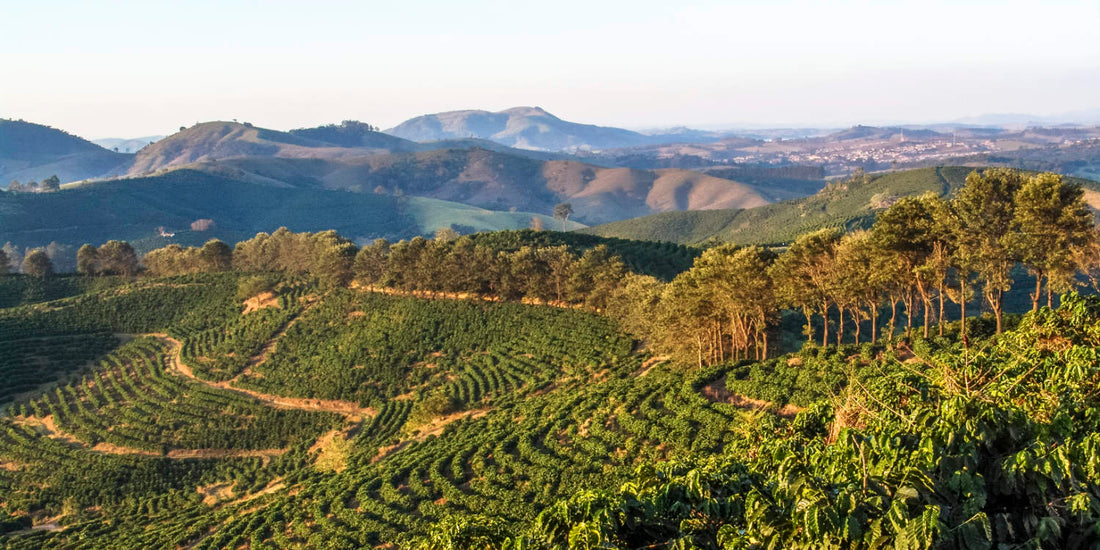Arabica and Robusta are two types of coffee grown commercially. In addition to them, there are others, but the volume of all coffee in the world does not exceed two percent. For example, Liberica, Excelsa, and Eugenioides.
Of the total production of Arabica and Robusta, Arabica - is about 70%, and its relative Robusta - is 30%. Many attribute the widespread taste preference for Arabica over its counterpart, however, what is often unknown is that it was created through a crossbreeding between Robusta and Eugenioides! Thus it stands to reason why consumers enjoy a more pleasant flavor with Arabica coffee beans.
The rare, exquisite Eugenioides coffee is grown on delicate shrubs in limited quantities due to its small beans and low yield. Not only does this type of bean have an exceptionally low caffeine content, at just 0.2%, but it also has considerably less than Arabica or Robusta varieties - making it a unique and precious variety!

Arabica Bean Shape Is Longer, Robusta Bean Is More Round. credit Tasty Coffee
When it comes to Arabica and Robusta coffee beans, many obvious distinctions can be identified. From their physical appearance to the way they grow, as well as taste preferences and costs. Let us further analyze these two types of coffee to comprehend why they vary so drastically from each other.
growing conditions
Arabica beans are especially fragile and need timely care to produce a quality crop. Growing Arabica is an expensive feat, as it requires exceptionally high altitudes ranging between 600-2000 meters (2000-6500 feet) or even higher for ideal bean growth. To get the most out of your investment, you must continually fertilize the soil and in some cases construct artificial irrigation systems around each tree to avoid any risk of disease.
Robusta thrives best under warm conditions, so it is mainly cultivated in tropical climates. But this crop proves to be incredibly resilient regardless of terrain - whether mountains or plains - and extreme temperatures, as well as intense rainfall. It requires minimal maintenance and care due to its sturdy nature.
47 Countries Which Grow Coffee

Brazil is the world's largest producer of Arabica coffee, having produced an estimated 2.08 million tons in 2011. Vietnam, however, held a distant second place with ≈ 660,000 tons of Robusta that same year - though impressive considering its much smaller size compared to Brazil’s expansive coffee plantations. Coffee connoisseurs agree: there's no comparison for taste!
Boasting high levels of lipids and sugars, Arabica beans create an intense flavor experience that is both sweet and acidic. With some varieties coming from specific regions, you can even taste notes of berries and citrus fruits while enjoying the aromas of flowers or nuts.
Caffeine content
With more caffeine and chlorogenic acid, Robusta is the drink of choice for those looking to boost their energy. However, its higher levels of caffeine can make coffee taste bitter and heavy - not something many people want in their morning cup! The flavor profile of this type of bean is tart with a flat finish making it difficult to achieve delicate nuances like Arabica coffees can do.
Taste and flavor
Foam on top - cream is the most delectable and fragrant component of espresso. Robusta beans provide a more voluminous layer of cream than their Arabica counterparts.
The flavor of coffee is derived from the effort and attention that goes into cultivating it on the farm. While Robusta beans are more forgiving than Arabica when it comes to climate conditions, they still require proper care to produce a delicious cup of coffee. Paying close attention and taking good care of your Robusta will yield far better results than neglecting an Arabica bean crop.
And don't drink instant coffee. Despite the claims of manufacturers, it is almost always made from cheap Robusta. Although it also happens that it is made from good specialty coffee, it is true that in this case, it is quite expensive.
Price
Arabica is expensive due to its limited access growth location in the mountains, which makes it difficult and costly to cultivate, transport, and process. Additionally, fertilizers and irrigation are also pricey investments that come with growing Arabica beans. If a bad year strikes then surviving crops will be even pricier as they become more scarce.
Robusta trees are three to four times larger than Arabica and can reach heights of up to 13 meters. Despite not needing extra height, Robusta is resilient in the face of rain, heat, and disease - all of which result in a lower production cost compared to Arabica beans. This makes Robusta much more affordable on the market while still providing just as delicious flavor.

Prices on the exchange for Robusta and Arabica coffee indicate what you may expect to pay, however, prices for high-quality coffees will be significantly higher.
To minimize expenses, budget-friendly coffee cafes frequently use a combination of Arabica and Robusta. This is advantageous for two reasons: you can reduce costs without compromising on flavor. So if Arabica offers such an exquisite taste, why would we need to include Robusta in the mix?
When it comes to Arabica and Robusta beans, there is no clear consensus on which one reigns supreme. Some might argue that Robusta should not be used at all while others dedicate their research to combining the two varieties to create unique tastes. Because of this disparity, it's up to each coffee connoisseur or barista to decide what works best for them!
Robusta provides a strong espresso crema, body, and flavor. Unfortunately, the taste can be slightly bitter with an intense aroma, however, this doesn't mean that nothing delicious can be made using Robusta!
For those who yearn for a classic Italian coffee experience, there's nothing quite like the deep-roasted blend of Arabica and Robusta. Cheaper than pure Arabica alone, this delectable mix gives your cup that unique “bite” people have come to associate with true Italian espresso. When it comes to cappuccinos in particular, you'll love how hints of chocolate add an intriguing flavor as well – many find they prefer these blends over other coffees!
When crafting coffee in any form, such as French press, cezve or pour over, it is recommended to use Arabica beans rather than robusta. Using the latter can result in an unpleasantly bitter taste and should be avoided if possible.
Conclusion
Keep this in mind: you can always discover something exquisite within coffee that has been closely monitored. Delicious coffee is not simply Arabica or Robusta, but the result of careful crafting and preparation. The secret to an outstanding cup lies in paying attention to every step from roasting to brewing.

